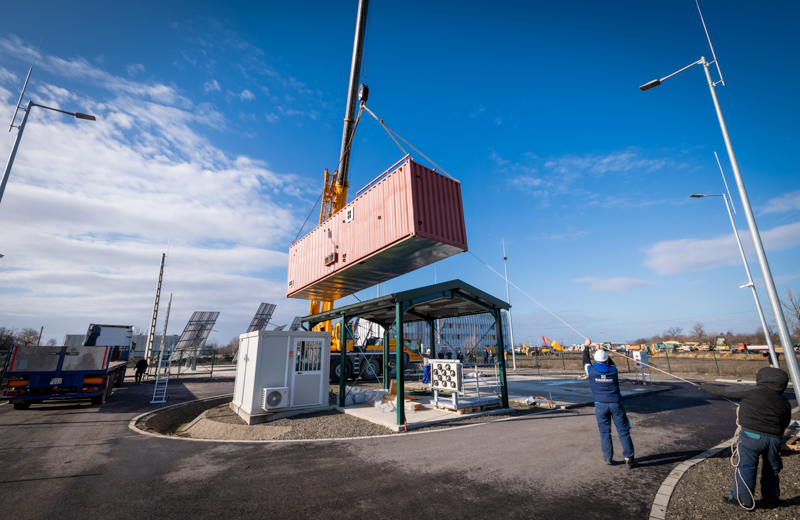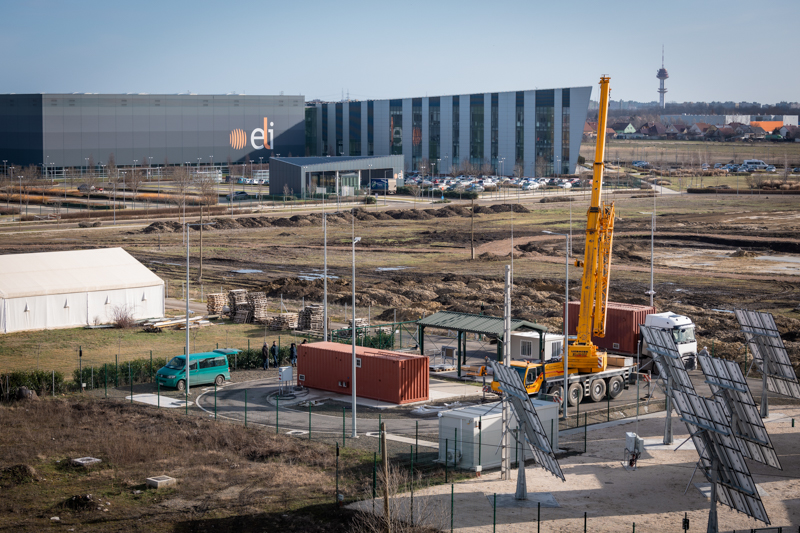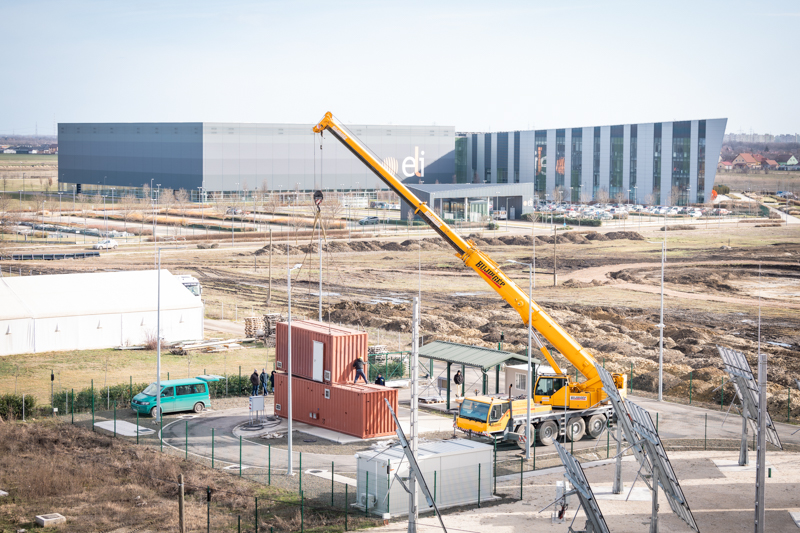
The first energy conversion equipment with which renewable energy will be used to produce hydrogen and then synthetic fuels has arrived at the energy innovation test station developed in the Science Park of the University of Szeged. Dr. Csaba Janáky, the head of the project, followed the placement of the containers on-site with his work group. The associate professor of the Department of Physical Chemistry and Materials Science of the University of Szeged, head of the SZTE IKIKK Competence Centre of Material, Environmental and Energy Studies, and co-professional head of the National Laboratory of Renewable Energies, explained what makes the project forward-looking.
The first containers with the self-designed equipment of the energy innovation test station to be built in the Science Park of the University of Szeged have arrived and been put in place. The test station is being developed in the framework of the environmentally friendly energy storage and conversion projects of the university and its partners, led by Dr. Csaba Janáky. The researcher said on the spot that renewable electricity from the solar farm operating on the station site will be used to produce hydrogen through the electrolysis of water in the containers that have just arrived. The "green" hydrogen obtained in this way, which can be stored on-site, can also serve as fuel and as a raw material for further energy conversion processes. In the second, soon-to-be-arrived container, liquid synthetic fuel (such as crude gasoline or kerosene) will be created from carbon monoxide and hydrogen produced by the electrolysis of carbon dioxide.

Dr. Csaba Janáky. Photo: Ádám Kovács-Jerney
According to Dr. Csaba Janáky, the energy innovation test station serves to test and further develop the developments already operating in the laboratories under conditions more suitable for industrial implementation.
– In the development processes, the stage when larger equipment is built and many problems arise with procedures that were working well in the laboratory, is called the Valley of Death. This type of testing is very resource-intensive compared to laboratory research, and it is not worth building your own test station for every research. Thinking about development directions at the university, we identified this gap a few years ago; we can occupy a good position in this since the test station will provide a unique service for the relevant industrial and academic actors both here and in Central Europe – said the researcher from Szeged.
The containers placed at the Science Park contain power-to-gas (P2G), that is, electrolysis technologies that produce gas from electricity. They will be followed in a few weeks by another container with power-to-liquid (P2L) technology devices that will be able to produce liquid synthetic fuel, largely from hydrogen and carbon monoxide from the other container. After connecting the two technologies - expectedly in April-May - the full operation of the energy innovation test station can start.
The test station is a joint project of the University of Szeged, Audi Hungaria car factory, István Széchenyi University, Pannon University, and Zoltán Bay Research Institute, which aims to produce synthetic fuels and validate them in stages. The gasoline and kerosene produced with renewable energy at the innovation station in Szeged will be refined at Pannon University, and Audi will initially mix 2-3% of it into the currently used gasoline and test its engines with it, examining the effects. Looking into the more distant future, Dr. Csaba Janáky said that, according to the plans, larger equipment can be built for the production of synthetic fuel (with the involvement of other industrial players), and depending on the results, 10-20 percent of new fuel may be included in the gasoline tested by Audi in the future. Attention to new fuels will increase in the next decade, since after 2035, only internal combustion engines running on synthetic fuel will be sold in Europe.
Dr. Csaba Janáky said that at the station, they will investigate how and with which procedures the production and use of these synthetic fuels can be carried out most efficiently technically, and in terms of costs. According to the researcher from the University of Szeged, this is where the test station's market potential lies: they will be able to compare multiple production routes under relatively standard conditions, thus showing which process is more efficient from an energetic, technical, or economic point of view.
The test station will also be open to partner companies and academic institutions:
– If a company wants to test a component, say a catalyst, an electrolyzer cell, or a catalytic reactor, it contacts us, together we develop a plan for the test, run the measurement campaign, and finally issue a test result. The construction is still going on, but there are already applicants, even from America, who would bring an electrolyzer cell stack here to test. This means income for the university, with which we will be able to ensure the self-maintenance of the station, and it can also bring new industrial partnerships. We will be able to make development proposals to the testing partners that they can implement together with the University of Szeged – remarked Dr. Csaba Janáky.
                                               |
| PHOTO GALLERY: The arrival of the electrolysis technology containers at the SZTE Science Park. Photo: Ádám Kovács-Jerney |
Building of the various elements of the test station is financed by three major projects running at the University of Szeged: the National Laboratory for Renewable Energies (RRF-2.3.1-21-2022-00009), the joint project with Audi for the production of synthetic fuels, and the joint hydrogen production project with the Bükkábrány Energy Park (2020-3.1.2-ZFR-KVG-2020-00003).
The test station's expansion plans include several other research programs. In the container of the solar park, for example, used batteries removed from cars will be tested to see if they are suitable for a second use to store the energy produced by the solar power plant. Dr. Csaba Janáky wants to ensure the operation of electrolysis at night with this environmentally friendly method. According to his assumption, the secondary use of used car batteries is even possible for 4-6 years.
The equipment designed by the SZTE research group was installed in containers by GanzAir Compressor Technology in Kiskunhalas and transported to the SZTE Science Park.
Article by Sándor Panek
Translated by NKI
Featured image: The placement of the container with the electrolysis technology in the SZTE Science Park. Photo: Ádám Kovács-Jerney

